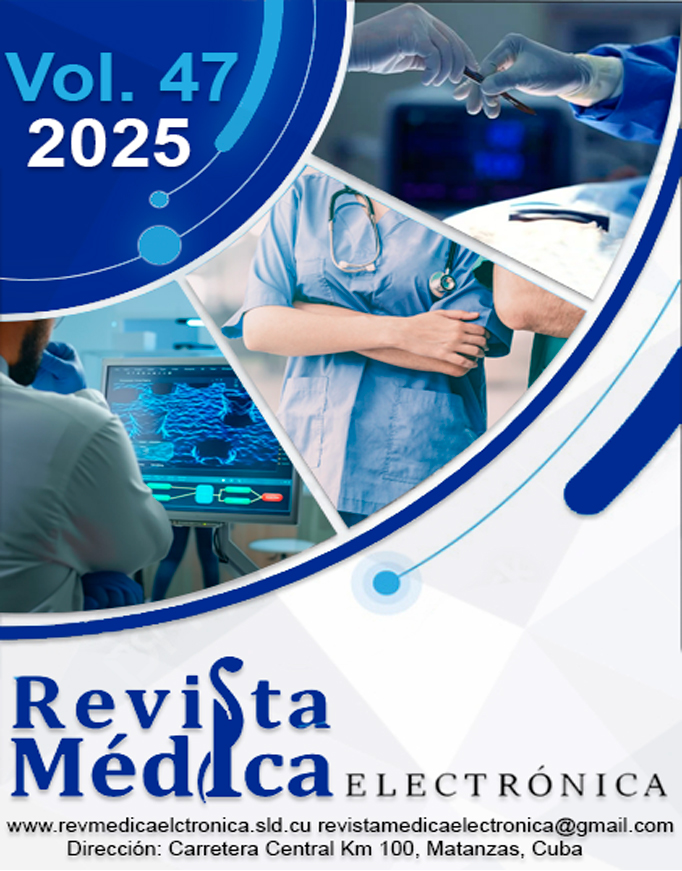Parkinsonism and epilepsy as clinical manifestations of bilateral cerebral calcinosis. Case report
Keywords:
cerebral calcinosis, parkinsonism, epilepsy, hypoparathyroidism, Fahr syndromeAbstract
Basal ganglia calcifications are a radiological finding in approximately 20 % of the general population and can be present in a variety of medical conditions. When they appear simultaneously, involving structures such as the globus pallidus, putamen, dentate nucleus of the cerebellum, and hemispheric white matter, they are pathological and have a wide spectrum of clinical manifestations. The case presented is a 69-year-old female patient who underwent thyroidectomy due to a tumor approximately 15 years ago, with postoperative hypothyroidism and hypoparathyroidism. She presented with motor clumsiness, tremor; epileptic seizures with sudden loss of consciousness and generalized tonic-clonic movements, irritability, anxiety, depression, impaired recent memory, and sleep disturbances. Physical examination revealed symmetrical parkinsonism associated with late-onset epilepsy and a possible structural etiology. Based on the patient's history, neuropsychiatric manifestations, and the CT scan demonstrating bilateral cerebral calcinosis, the patient was diagnosed with Fahr syndrome secondary to postsurgical hypoparathyroidism. This case is of interest because it constitutes a rare nosological entity, and is reported with the objective of characterizing parkinsonism and epilepsy as clinical manifestations of these calcifications. A diagnosis of parkinsonism with symmetrical presentation of cardinal motor signs, postural and action tremor, late-onset epilepsy, and psychiatric manifestations raises suspicion of a possible structural lesion, such as bilateral cerebral calcinosis. Determining whether it is this disease or Fahr syndromes, and identifying the etiology in the latter, are of therapeutic and prognostic importance.
Downloads
References
1. Montenegro Pérez JA, Franco Torres VJ, Vargas Tobios RC, et al. Movimientos coreiformes y calcificaciones ganglio basales como presentación de la enfermedad de Fahr. Acta med colomb. 2023;48(1). DOI: 10.36104/amc.2023.2635.
2. Moreno Reina C, Zarauza Valero GA, Royo Solé JM, et al. Calcificaciones intracraneales en TC: Guía básica de su caracterización y manejo. Seram [Internet]. 2021 [citado 02/02/2025];1(1). Disponible en: https://piper.espacio-seram.com/index.php/seram/article/view/4426
3. Dávila-Hernández CA, Bendezú-Ramos GF, Torres-Luján M, et al. Calcificaciones cerebrales: enfermedad o síndrome de Fahr. Rev Soc Peru Med Interna. 2021;34(1):12-4. DOI: 10.36393/spmi.v34i1.579.
4. Pinzon Tovar A, Mendez H, Jimenez-Salazar S, et al. Espectro clínico del síndrome de Fahr: reporte de dos casos. Rev Colomb Endocrinol Diabet Metab. 2022;9(3):e752. DOI: 10.53853/encr.9.3.752.
5. Navas-Campo R, Moreno Caballero L, Cajal Calvo JR, et al. Enfermedad o Síndrome de Fahr. Lo que el radiólogo debe saber. Seram [Internet]. 2021 [citado 02/02/2025];1(1). Disponible en: https://piper.espacio-seram.com/index.php/seram/article/view/4463
6. Guerra Garijo T, Castaño Yubero C, Guerra Garijo M. Cuando el cerebro tiene demasiado calcio. Enfermedad de Fhar. Seram [Internet]. 2022 [citado 02/02/2025];1(1). Disponible en: https://piper.espacio-seram.com/index.php/seram/article/view/9488
7. Pampa Rodríguez RA, Soliva Martínez D, Jean Pierre V, et al. Síndrome de Fahr, claves para el diagnóstico radiológico. Seram [Internet]. 2018 [citado 02/02/2025];2(1). Disponible en: https://piper.espacio-seram.com/index.php/seram/article/view/8231
8. Mendoza-Cáceres MA, Rozo-Ortiz EJ, Fonseca JN, et al. Síndrome de Fahr e hipoparatiroidismo. Rev ecuat neurol. 2023;32(2):127-31. DOI: 10.46997/revecuatneurol32200127.
9. Cadena-Martínez A, Gonzalez-Acosta CA, Rojas-Cerón CA. Calcificaciones Ganglio Basales Simétricas Bilaterales (Enfermedad De Fahr) en Pediatría: Reporte De Caso. Rev ecuat neurol. 2022;31(2):84-90. DOI: 10.46997/revecuatneurol31200084.
10. Aguilar Pesantez MdJ, Cabrera Contreras GP, Ochoa Arevalo VF. Síndrome de Fahr en un paciente pediátrico. Reporte de caso. Rev Fac cienc méd Univ Cuenca. 2020;38(3). DOI: 10.18537/RFCM.38.03.09.
11. Roa Ortiz M, Mendoza Rojas V. Síndrome de Fahr secundario a hipoparatiroidismo: una causa infrecuente de movimientos anormales en niños. Acta Pediatr Esp [Internet]. 2020 [citado 02/02/2025];78(3-4):e164-6. Disponible en: https://www.actapediatrica.com/index.php/secciones/notas-clinicas/1704-sindrome-de-fahr-secundario-a-hipoparatiroidismo-una-causa-infrecuente-de-movimientos-anormales-en-ninos
12. Mora-Garzón ER, Restrepo Valencia CA, Parra Santacruz CP, et al. Hipoparatiroidismo primario con síndrome de Fahr como causa de epilepsia refractaria. Rev Colomb Endocrinol Diabet Metab [Internet]. 2021 [citado 02/02/2025];8(4):e717. Disponible en: https://revistaendocrino.org/index.php/rcedm/article/download/717/943/4057
13. León Castellón R, Real Cancio RM, Domínguez González WH, et al. Síndrome de Fahr por hipoparatiroidismo secundario. Rev Cubana Neurol Neurocir [Internet]. 2020 [citado 02/02/2025];10(1). Disponible en: https://revneuro.sld.cu/index.php/neu/article/view/354/588
14. Olivera Vega M, Garzón Cutiño L, Cabrera Rodriguez D. Fahr's disease in a patient with sensorineural hypoacusia: case report. Rehab Interdiscip. 2024;4:41. DOI: 10.56294/ri202441.
15. Jiménez-Ruiz A, Cárdenas-Sáenz O, Ruiz-Sandoval JL. Symmetrical and bilateral basal ganglia calcification. Case series and literature review. Gac Med Mex. 2018;154:210-4. DOI: 10.24875/GMM.M18000137.
Downloads
Published
How to Cite
Issue
Section
License
Copyright (c) 2025 Guillermo Alberto Viltres-Rodríguez, Bettys Rodríguez-Pérez, Yaquelyn García-Lujardo

This work is licensed under a Creative Commons Attribution-NonCommercial 4.0 International License.
All content published in this journal is Open Access, distributed under the terms of the CC BY-NC 4.0 License.
It allows:
- Copy and redistribute published material in any medium or format.
- Adapt the content.
This will be done under the following terms:
- Attribute the authors' credits and indicate whether changes were made, in which case it must be in a reasonable way.
- Non-commercial use.
- Recognize the journal where it is published.
The copyrights of each article are maintained, without restrictions.






